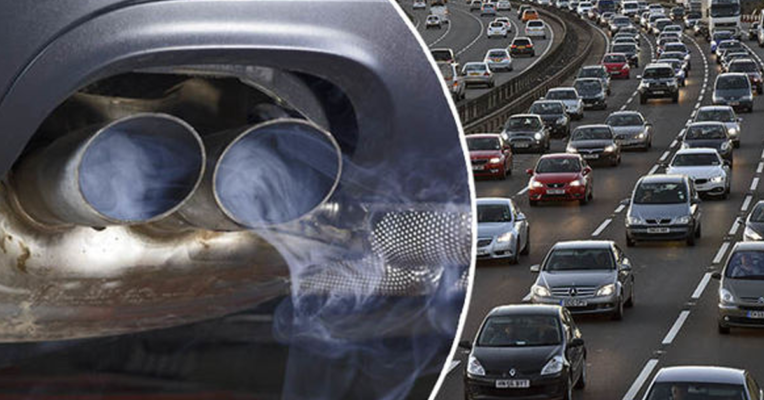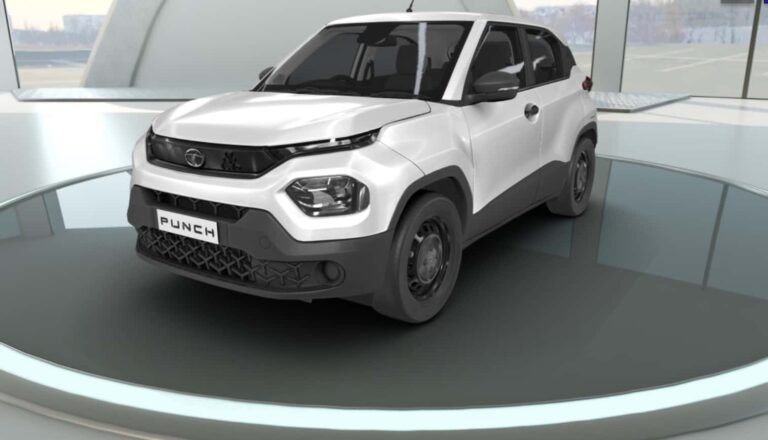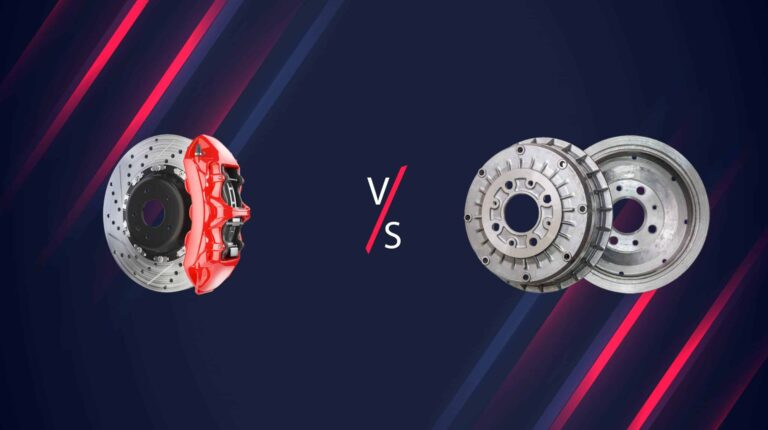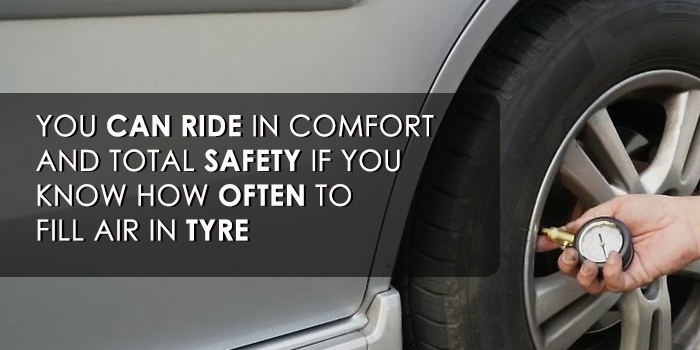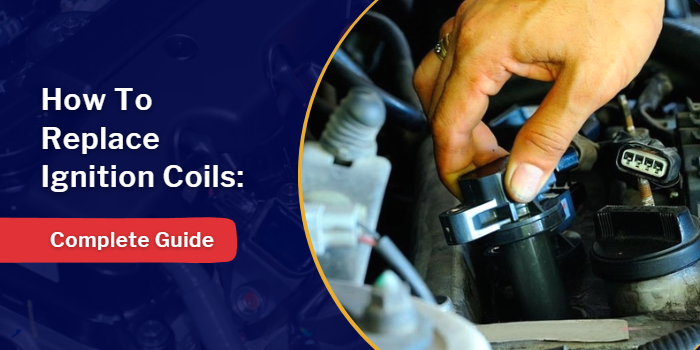
All modern petrol engines use ignition coils to create a high voltage at the spark plug to combust fuel. If you are thinking of improving the performance of your car, increasing fuel economy or are having trouble with a rough running engine, then you should learn how to replace ignition coils.
The ignition coil forms part of the electric ignition system in a car’s engine. The battery supplies a low voltage to the ignition coil which steps it up to a higher voltage and sends it to the distributor. The distributor supplies the spark plug with this high voltage to create a large spark that burns fuel in the combustion chamber. Newer systems are completely electronic and do not require a distributor. They rely on an ECU to govern the distribution of voltage to the required spark plug.
Also Checkout What Is A Fuel Injection System? And It’s Purpose
What is an Ignition Coil? Why Do We Need One?
An ignition coil is basically a step-up transformer. It is used to transform low voltage from the battery to a high voltage to the spark plug. The battery is rated at 12 volts which is not sufficient to create a powerful spark in the combustion chamber. Ignition coils can degrade over time due to overheating from constant use, wear and tear. Faulty ignition coils are easy to identify. Keep an eye open for common symptoms of a bad ignition coil if you want a smooth and trouble-free drive.
Here Checkout How Does The Cooling System In An Engine Work
What are the common symptoms of a faulty ignition coil?
Here are some sure signs that you need to replace your ignition coils.
Dashboard Warning Light
You should see a check engine warning light on your instrument cluster when ignition coils go bad. Click here to read about Car Dashboard Symbols and Their Actual Meanings.
Erratic and Rough Engine
Rpms will vary with throttle input and you will not have a smooth engine. The performance will drop drastically with a bad ignition coil.
Misfiring Cylinders
This happens when the spark plug fails to fire at the right time or doesn’t produce a spark to ignite the fuel.
Starting Trouble
The engine may refuse to start easily with a faulty ignition coil set.
Also checkout: How to recharge your car battery
How Do You Fix or Replace a Bad Ignition Coil
If you notice any of the symptoms mentioned above, then you should test your ignition coil for proper functioning. Use a multimeter to test the resistance over the primary and secondary coils of the ignition coil. An onboard diagnostic scanner will identify a faulty ignition coil for a car equipped with an ECU.
Also, look for signs of mechanical damage such as burnt sockets, broken wires or faulty valve gaskets.
First, disconnect the battery terminals to avoid an electrical shock. Once you gain access to the ignition coil, disconnect its electrical connections and undo the screws of the mounting bracket.
Twist the ignition coil out of its assembly housing and replace it with a new ignition coil. This is a good time to check the spark plug of the concerned cylinder.
Reconnect the battery terminals and start the engine. Take your car for a test drive to check for smooth operation. You should see a marked improvement in engine performance. Fuel economy will also increase as you rack up the miles.
The warning light on the instrument cluster should disappear. If it doesn’t, try resetting the ECU to clear the error codes.
Read Here Ultimate Guide To Engine Bay Detailing
Conclusion
The ignition coil is an important component for the proper functioning of the engine. Without it, the spark plug would not produce the powerful spark required to ignite fuel in the combustion chamber.
Pay attention to the common indicators of a faulty ignition coil mentioned in this article. Ask a certified mechanic to inspect the ignition system if you notice any irregularities while driving.
Replacing the ignition coil is a straightforward task that can be achieved in around 2 hours and at a cost of Rs.2000 for a new ignition coil. All you need are some common hand tools and a bit of elbow grease.
For other interesting articles, tips and tricks, car comparisons and automotive advice, visit the Carorbis blog. You may like to check out the Basic Bad Spark Plug Symptoms In A Car or The 7 Signs Of Bad Ignition Coils In An Engine.
Frequently Asked Questions
Q1. What to Do After Changing Ignition Coil?
Ans. Once the ignition coils have been replaced, start the engine and take the car for a short test drive. Check if the engine is running smoothly and that there are no sudden jerks or stalls. Acceleration should be adequate as the powerplant responds to throttle inputs. Ensure that the check engine warning light has disappeared from the instrument cluster.
Q2. How to Change Ignition Coil Motorcycle?
Ans. Motorcycles provide more space to work on the engine as compared to a car or an SUV. First, remove the fuel tank and motorcycle seat to access the ignition coil. Unscrew the mounting bracket for the ignition coil and disconnect the ground and live wire. Remove the spark plug wires and replace the ignition coil with a new one.
Q3. Can I Replace Ignition Coil Myself?
Ans. Replacing the ignition coil can easily be done at home with some simple tools, a multimeter and the new ignition coil part. Since you are dealing with electrical components, ensure to disconnect the battery before starting work on the engine. Use insulated gloves and be gentle with sensitive parts like the spark plug insulator boots and electrical connectors.
Q4. Is It Easy to Replace Ignition Coils?
Ans. Replacing the ignition coil on an engine is not a challenging task. The difficult part is gaining access to hard-to-reach areas of the engine bay. You also must be careful about plastic and rubber components that may break during removal. The entire job can be done in under 2 hours if you have all the tools and parts at hand.
Q5. Should You Replace Ignition Coils All at Once?
Ans. It is not necessary to replace all the ignition coils in one go. Identify the faulty ignition coil and replace only that one. It will have no effect on the other ignition coils. However, check the condition of the other ignition coils because they are likely to fail over time. You should not drive your car with a faulty ignition system.
Q6. What Tools Do I Need to Replace an Ignition Coil?
Ans. You will need a toolset which includes rachets, sockets and extensions. A torque wrench is required to undo the spark plugs and other parts. Have a multimeter with you to test the electrical connections. Wear a pair of insulated gloves and safety glasses for your protection.
Q7. Where Are Ignition Coils Located?
Ans. The ignition coil is part of the ignition system. It sits between the battery and the distributor or CDI unit. The distributor provides high tension voltage to each spark plug placed above the cylinder. Modern engines have the ignition coil mounted directly over the spark plug.
Q8. How Long Does It Take to Replace Ignition Coil?
Ans. You can replace an ignition coil in under 2 hours with the right tools and basic knowledge of engine electrical systems. It is a good idea to change the spark plugs while you are at it since they will be easily accessible during an ignition coil replacement. You will save on labour costs if you replace the part yourself.
Q9. Should I replace ignition coils with spark plugs?
Ans. Spark plugs cost only around Rs.500 and should be replaced along with faulty ignition coils. A bad ignition coil would have caused misfires and incomplete combustion, which would result in carbon build-up on spark plug gaps. You will have a smooth-running engine when you replace these ignition components together.
Q10. What Does an Ignition Coil Look Like?
Ans. An ignition coil looks like a small metal cylinder with electrical wires protruding out of it. One of the wires connects to the battery while the other connects to the distributor. Modern ignition coils look like a tube made from plastic.
Q11. How Much Does an Ignition Coil Replacement Cost?
Ans. An ignition coil for a passenger car costs around Rs.1500 or maybe around Rs.2000 for a large SUV. Motorcycle ignition coils are cheaper at Rs.300 -500. If you have them replaced at a service centre you need to factor in labour costs as well. It is best to carry out the work at home if you have the right tools.
Q12. How Many Coils Are in a Car?
Ans. Usually, a single ignition coil can power one or two cylinders in the engine. So, a four-cylinder car may have either 2 or 4 ignition coils depending on their specifications. Identify the faulty ignition coil and replace only that one. You don’t need to replace all the ignition coils at once as they do not depend on each other to work.
Q13. What Are the Symptoms of a Failing Ignition Coil?
Ans. The engine will suffer from loss of power and poor fuel economy. Idling will be rough and cylinders may misfire or even backfire occasionally. The check engine light may illuminate the instrument cluster accompanied by jerky motion, difficulty in starting and engine stalls without warning. Without a proper spark, the air-fuel mixture cannot combust to make sufficient power.
Q14. Is the Ignition Coil the Same as a Coil Pack?
Ans. A coil pack is an alternative name for an ignition coil. The coil pack is used to step up the battery voltage and transfer this current to the distributor toward the cylinder spark plugs. Newer cars have an electronically controlled ignition system that is governed by the car’s computer, the ECU. It sends the spark at the right time for the cylinders to work.
Q15. How Many Coils Are in a Coil Pack?
Ans. A coil pack or ignition coil has two sets of coils. The primary coil and secondary coil. Current flows through the primary coil (fewer windings) and induces a high voltage in the secondary coil (greater number of windings). This step-up transformer process is required for the spark plugs to ignite the air-fuel mixture in the combustion chamber.
Q16. What’s the Difference Between Spark Plugs and Ignition Coils?
Ans. The ignition coil converts low voltage from the battery terminals to a high voltage that is sent to the right spark plug at the right time. The spark plug creates a powerful spark across its conductor gap to ignite the air-fuel mixture in the engine. Both the spark plug and ignition coil consist of the ignition system in an engine.
Q17. How Often Do You Change Ignition Coils?
Ans. An ignition coil will last for around 100,000 km or more if used under ideal conditions. This means normal driving conditions with regular service intervals. In an electronically controlled ignition system, the ECU takes care of the electrical system and will report an error if the ignition coil is faulty. For older cars, a bad ignition coil will cause poor engine response or stalling.
Q18. Are Cheap Ignition Coils Any Good?
Ans. Inexpensive ignition coils run the risk of wearing out prematurely due to inferior materials used in their construction. Since they are electrical devices, they are subject to high voltage and heat which can damage sensitive copper wires and electrical connectors. It is advisable to use OEM ignition coils for a reliable and safe driving experience.
Q19. Will New Ignition Coil Improve Performance?
Ans. As ignition coils wear out over time, they may not produce the right voltage at the spark plug resulting in incomplete combustion of fuel in the engine. This will result in unresponsive acceleration together with an engine that does not run smoothly. A new ignition coil will improve performance if the old part has worn out. There are also high-performance ignition coils used in racing engines but they use upgraded pistons, cylinders and ignition systems.
Q20. Will Changing Ignition Coil Improve Performance?
Ans. You don’t need to change the ignition coil unless it is proving problematic while driving. Consult a service technician before upgrading the ignition coils in your car.
Q21. Are Aftermarket Ignition Coils Worth It?
Ans. Aftermarket ignition coils are good if they are of the same quality and specifications as OEM parts. Otherwise, you may be compromising on engine performance and safety.
Q22. Are Upgraded Ignition Coils Worth It?
Ans. Upgraded ignition coils will usually have the advantage of creating a bigger spark with a higher voltage rating. The fuel burns easier and creates more horsepower. But make sure that the ignition system/engine components can accommodate these higher specifications.
Q23. Are Aftermarket Ignition Coils as Good as OEM?
Ans. Aftermarket ignition coils can be better than OEM parts if they are from reputed brands and are manufactured from high-quality materials. There are also inferior aftermarket ignition coils available that can compromise engine performance.
Q24. Can You Use Different Brands of Ignition Coils?
Ans. It is best to use OEM-specified ignition coils, or at least the same brand of ignition coils for your engine. Avoid mixing different types of ignition coils as they may cause engine issues over time.
